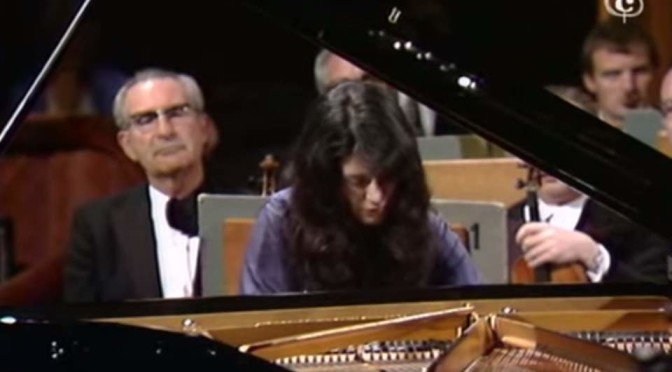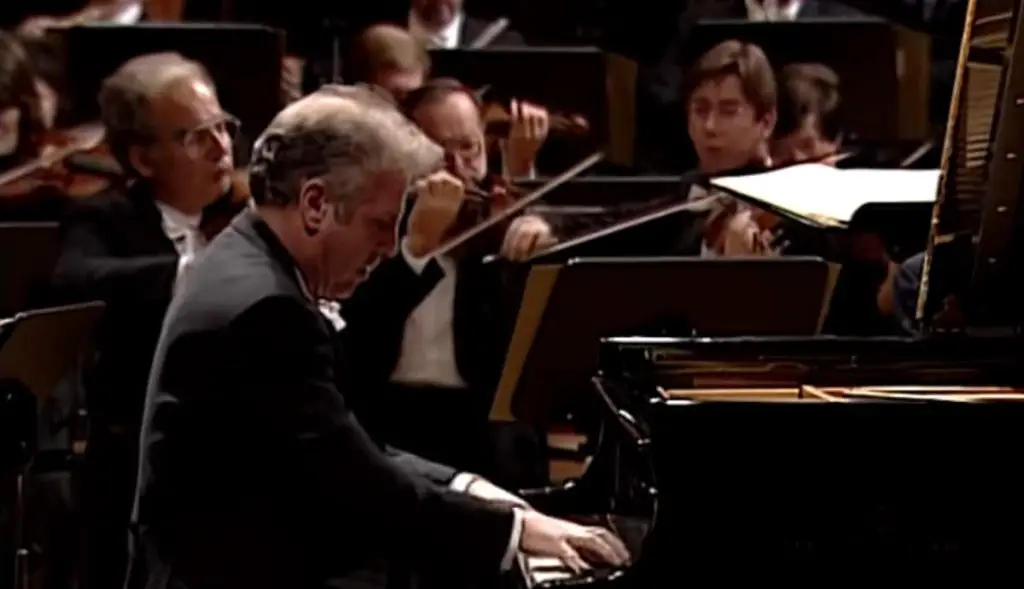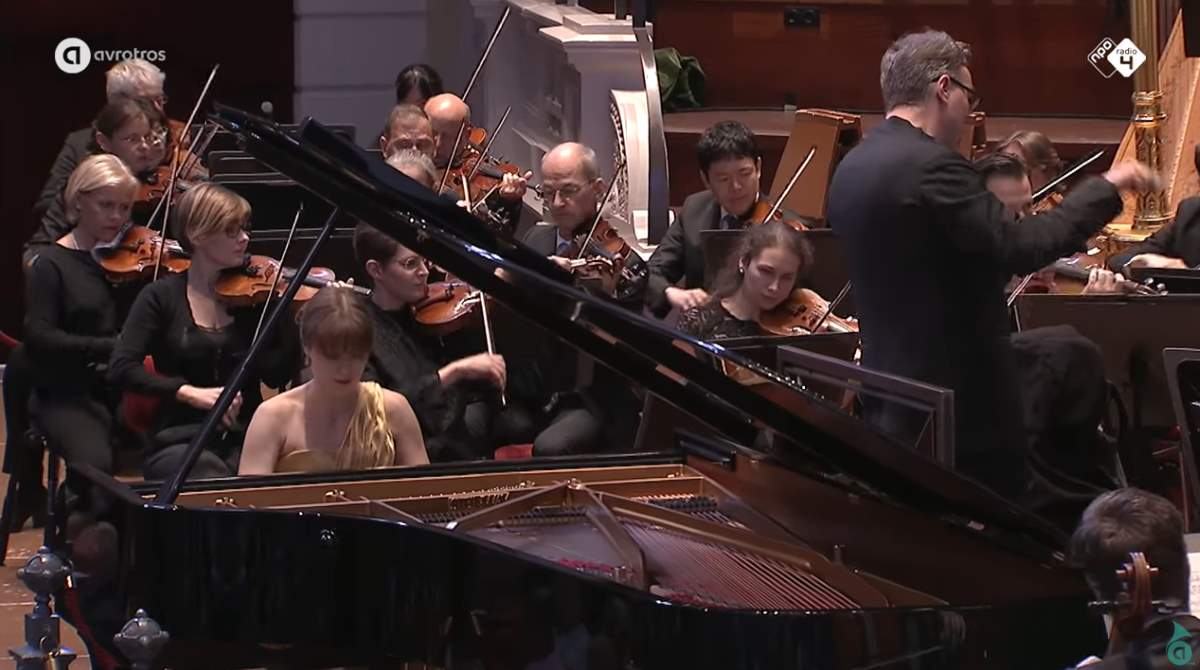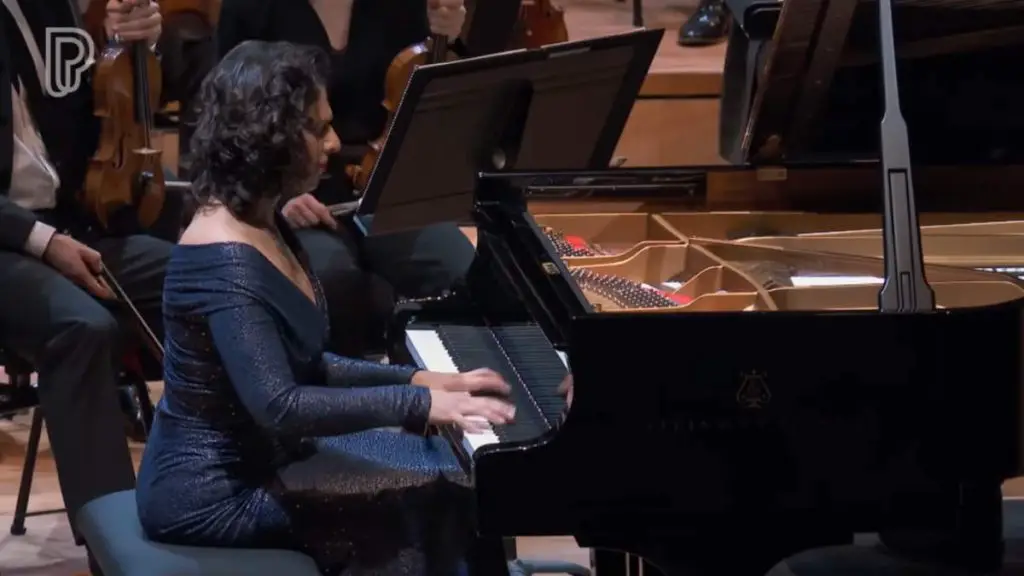Accompanied by the Orchestre de la Suisse Romande, widely regarded as one of the greatest pianists of the second half of the 20th century, the Argentine pianist Martha Argerich performs Pyotr Ilyich Tchaikovsky’s Piano Concerto No. 1 in B-flat minor, Op. 23. Conductor: Charles Dutoit. Concertmaster (lead violinist): Peter Rybar (Vienna, 29 August 1913 – Lugano, 4 October 2002), the Czech-Swiss violinist. Year of the recording: 1975.
Tchaikovsky’s Piano Concerto No. 1
Tchaikovsky’s Piano Concerto No. 1 in B-flat minor, Op. 23, is one of the most famous and frequently performed piano concertos in the classical repertoire. Composed in 1874-1875, this work represents a pinnacle of Romantic music, featuring rich melodies, striking emotional depth, and a complex but engaging dialogue between the piano soloist and the orchestra. Tchaikovsky initially dedicated the piece to Nikolai Rubinstein, a well-known pianist and conductor, who ironically criticized the work heavily upon first hearing it. This led Tchaikovsky to revise the concerto and instead dedicate it to Hans von Bülow, a German pianist and conductor, who successfully premiered the work in Boston, USA, in 1875.
The concerto opens with an instantly recognizable theme that has permeated popular culture as well as classical music circles. Though it starts with grand, dramatic chords, the work is also filled with intricate lyrical sections that allow the piano to showcase its full expressive range. The interplay between the soloist and the orchestra is dynamic and filled with tension, effectively capturing the audience’s attention from start to finish.
One of the fascinating aspects of this concerto is how Tchaikovsky masterfully blends Western classical traditions with Russian folk elements. While he was rooted in the European Romantic tradition, he also sought to express a uniquely Russian character through his music. This is evident in the emotional depth of the concerto, as well as in the various melodic and rhythmic patterns that often echo Russian folk tunes.
This piece also had a significant impact on the piano repertoire and has become a staple for many professional pianists. Its technical demands are considerable, requiring both exceptional skill and emotional understanding from the soloist. There are sections that necessitate rapid fingerwork, large leaps, and extreme dynamics, making it a challenging yet rewarding experience for both the performer and the audience.
Tchaikovsky’s Piano Concerto No. 1 in B-flat minor is not just a showpiece for the piano soloist but also a work of deep emotional and musical complexity. Its blend of Romantic expressiveness, technical virtuosity, and subtle nods to Russian folk culture make it an enduring classic that continues to captivate audiences worldwide.
Movements
1. Allegro non troppo e molto maestoso – Allegro con spirito
The first movement of Tchaikovsky’s Piano Concerto No. 1 is marked “Allegro non troppo e molto maestoso – Allegro con spirito.” It’s a captivating movement that sets the stage for the entire concerto, featuring a blend of virtuosity and emotion that has made it a staple in the piano repertoire. The movement is predominantly in the key of B-flat minor, though like many Romantic works, it explores a variety of tonal landscapes.
One of the most distinguishing characteristics of the first movement is its iconic opening. This starts with a commanding statement from the orchestra, laying out a grand and memorable theme. This theme is bold and brimming with emotional power. Interestingly, this theme doesn’t serve as the main subject of the movement; instead, it acts more like an introduction. After this initial section, the tempo picks up, and the piano enters, leading into the primary themes of the movement.
A striking feature of the first movement is the dialogue between the piano and the orchestra. This isn’t a simple back-and-forth; it’s a complex interplay where the soloist and orchestra frequently share thematic material, trading roles as leaders and accompanists. The piano part is technically demanding, filled with rapid scales, arpeggios, and dramatic leaps that require both technical proficiency and emotional nuance from the performer.
Another notable aspect is how Tchaikovsky fuses Western Romantic idioms with Russian elements. The themes are deeply expressive, yet they often bear the imprint of Russian folk music, both in their melodic contour and rhythmic structure. This cultural blend enriches the music, giving it a universal appeal while still grounding it in Tchaikovsky’s own heritage.
As the movement progresses, it goes through a series of thematic developments, modulations, and recapitulations, following the rough outlines of sonata-allegro form, but with Tchaikovsky’s own innovative twists. The movement eventually culminates in a coda that revisits the opening material, bringing the movement to a thrilling close.
2. Andantino semplice – Prestissimo – Tempo I
The second movement of Tchaikovsky’s Piano Concerto No. 1 is marked “Andantino semplice – Prestissimo – Tempo I,” and it serves as a poignant contrast to the fiery passion of the first movement. It is generally shorter than the other movements but is packed with emotional intensity. The movement is largely in D-flat major, which provides a lyrical, serene setting.
The piano and the orchestra enter into a more collaborative, gentle exchange in this movement, as compared to the dramatic interplay of the first movement. The opening theme is introduced by the flute, a tender melody that is soon taken over by the piano. This tune is elegant and relatively simple, which allows the emotional sincerity of the music to shine through. Tchaikovsky doesn’t weigh down this part of the concerto with heavy orchestration; instead, he opts for a lighter texture that gives the piano and woodwinds ample room to breathe.
Following the gentle Andantino section, the movement transitions into a Prestissimo middle section. This part adds a touch of zest and showcases the virtuosic capabilities of the piano. It’s as if Tchaikovsky momentarily interrupts the serene mood to inject a burst of energy. However, this section is relatively brief, and the movement returns to the initial Andantino tempo and thematic material, allowing the movement to conclude in a calm and reflective manner.
The second movement is often described as a lyrical intermezzo, a temporary respite that prepares the listener for the more intense final movement. It’s a blend of Romantic expressiveness and classical form, all encapsulated in a relatively brief span of time. The movement beautifully demonstrates Tchaikovsky’s gift for melody and his ability to convey a wide emotional range within a compact structure.
The second movement may not be as overtly virtuosic as the first, but it demands a different kind of skill from the soloist, a skill rooted in emotional expression and subtlety. The performer must balance the contrasting sections effectively to keep the inherent tension and emotional progression of the movement intact.
3. Allegro con fuoco – Molto meno mosso – Allegro vivo
The finale of Tchaikovsky’s Piano Concerto No. 1 is marked “Allegro con fuoco,” which translates to “fast with fire,” and it indeed lives up to that name. It’s an exhilarating finale, bursting with energy and virtuosity, designed to showcase the technical prowess of the soloist and leave the audience on the edge of their seats. The movement is set mainly in B-flat minor, aligning with the key of the first movement, and brings the concerto to a dramatic close.
Unlike the reflective, lyrical second movement, the third is all about vigor and excitement. It features several thematic sections, each with its own distinct character, but they all contribute to the movement’s overall sense of propulsion and triumph. The piano takes on a particularly dazzling role here, executing rapid passages, brilliant scales, and intricate arpeggios that require both finesse and raw power from the performer.
The orchestra is also given its moments to shine, introducing themes and engaging in a spirited dialogue with the piano. This lively interchange creates a kind of musical tension that makes the movement incredibly engaging. It’s as if both the soloist and the orchestra are participating in a joyful, intricate dance, constantly shifting between leading and following.
Tchaikovsky employs a rondo-like form in this movement, where the main theme recurs between contrasting episodes. This structure allows for a lot of thematic variety and development while maintaining a strong sense of unity and momentum. The recurring theme serves as a musical anchor, making each return feel like a triumphant homecoming.
The movement culminates in a grandioso coda, a final section where themes from the earlier parts of the movement are reprised and developed to bring the concerto to its conclusion. This is a section of pure musical spectacle, with the soloist and orchestra uniting to produce a climax of intense power and brilliance. It’s the kind of ending that often elicits immediate applause, sealing the concerto’s reputation as a crowd-pleaser.
Sources
- Piano Concerto No. 1 (Tchaikovsky) on Wikipedia
- Telemann: Concerto for Recorder and Viola da Gamba [Bremer Barockorchester] - July 23, 2024
- Gershwin: Rhapsody in Blue [Lang Lang] - July 21, 2024
- Tchaikovsky: Sérénade mélancolique [Julia Fischer] - July 19, 2024




